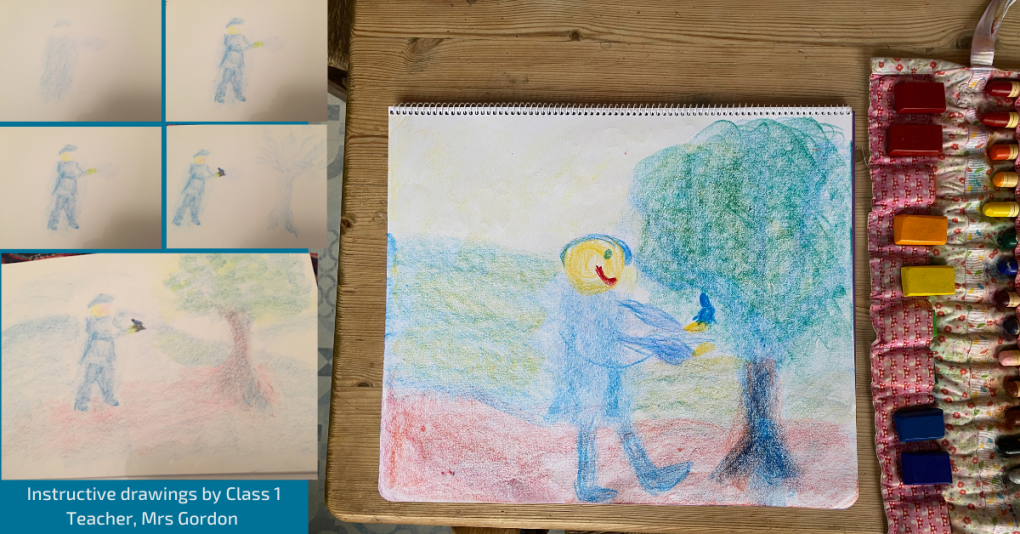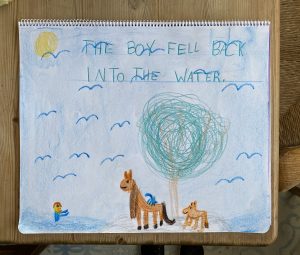Sustained attentive listening drawn out by Class 1
January 28 2021

None of us ever imagined that we’d design and deliver a Waldorf education via GSuite, yet we find ourselves once again in a strict lockdown, with a return to remote learning and teachers creatively adapting their lessons to be delivered in partnership with parents and carers.
Working with six Stockmar block crayons in the primary colours, Class 1 Teacher, Mrs Gordon, builds up a picture of a boy holding a mole from the equisite story ‘The Boy, The Mole, The Fix and The Horse’. This would normally be witnessed by the children developing on the chalkboard in front of them.
Chalkboard
The chalkboard is a hallmark if Steiner Waldorf education, standing as the focal point of the room. It serves as an artful aid that can depict a beautiful chalk drawing detailing a main lesson, presenting the curriculum in such a way that it stirs the imagination and feelings of the pupils in a manner that is hard to achieve on a white board.
It can be an interactive tool, as pupils participate in the lesson: getting up from their desk to add their written answer in number, letter, sentence or picture form for the class to view, offering an active alternative to answering through the spoken word in the sitting position at a desk.
All learning at this stage seeks to engage the feelings of the child so that strong personal identification with the subject matter can occur. Learning is essentially experiential, and strong and continuous narrative structures with an element of personification enhance direct experience. Imagination is a key quality, and pictorial imagery is a vital factor in making learning a personal inner experience.
The Tasks and Content of the Steiner-Waldorf Curriculum, page 24.
Instead, the developing picture was provided in a stage-by-stage printable format, given to parents / carers through their child’s individual pupil school email account. Taking out their crayon case and Main Lesson Books, the pupils then followed their teacher’s same footsteps through the different stages of building up the picture. The integration of the arts into all academic disciplines encourages the pupil’s emotional engagement with their learning.
Storytelling
The vast majority of the Class 1 curriculum is accompanied by stories. The pupil’s imagination is engaged with the story. In this aspect of their learning, where they listened to this same story over many days, they then went on to demonstrate their aural memory in further drawings of scenes from the story.
Listening to stories being told by a teacher in his or her own words ‘is a powerful experience and deeply engaging. At the same time, linguistic and listening skills are being exercised.’ (Ibid). Challenging events that are being experienced by children, such as the Covid pandemic, can be clothed in story form so that the listener can find ways to come to terms with their feelings.
Paradoxically, story is often more objective than a direct or moralising approach.
Communicating, exchanging viewpoints, dialogue and debate all have their place in lessons. The groundwork for such abilities is laid down in the younger classes. Narrative furthers this by exemplifying dialogue structure, by helping to shape experience into communicable form, and by cultivating listening, perhaps the key skill in the classroom’
Ibid, page 25.
Steiner Waldorf school consider a child to be ready for school at rising seven, when their development enables them to form mental pictures, establish memory, learn and focus attention.
If these forces are prematurely called upon, however, for formal learning of literacy or numeracy, for example, there can be a loss of vitality and a narrowing of the experiential basis for subsequent learning to build on…Many children are quite capable of applying their intelligence to tasks such as learning to read and write. The vital question is whether this intelligence should first be given time to develop social awareness through such things as creative play.’
(Ibid)
Later the children added two lines of writing about what is happening in the picture as part of their literacy practice, further demonstrating their sustained attentive listening, allowing them to relive the story in a deeper way, whilst exercising their conversation, memory, spelling and writing skills. The development of a good memory and recall are reliant on the spoken word, rather than the printed word or computers, and speech develops concentration and empathy, which are essential for formal learning.

BBC Radio 4 offered the exquisite abridged audiobook narrated by the author Charlie Mackesy free to all ages.
Although you may well find it in the children’s section of the bookshop, its sweet, wise sentiments have struck a chord with people of all ages from all over the world.” (BBC)
Materials of exceptional quality
Each child has at home with them their sixteen block and stick Stockmar crayons, which they began Class 1 with. Block crayons were developed in Waldorf schools. In order for the senses to be holistically addressed and stimulated, the materials need to be of a quality that is not just statistically measurable, but is also subjectively perceptible from an experiential, ‘feeling’ level.
Basic experiences like feeling, grasping and shaping act on the child’s brain and have a positive effect on the sensory motor development. In today’s world such a stimulus is more important than ever before. To add, they are safety-tested, non-toxic, child-safe, made with respect for people and planet; no crumbling, sticking, smudging; and are a purchase that can be passed down generations.
Stockmar, possibly the only stockist of block crayons, is used throughout Steiner schools across the world, by reason of their exceptional qualities, using raw materials that look to minimise any environmental impact. With the addition of pure beeswax to their formula, they aim at providing genuine artistic experience which develop and enhance the child’s senses.
Screen-free
The Lower School consciously is a technology low environment. Edinburgh Steiner School’s approach to the use of technology is guided by the same philosophy that steers the entire curriculum: The Right Thing At The Right Time. Waldorf schools carefully consider the classroom and campus environment for children so that wonder, imagination and creativity thrive.
Technological literacy – a crucial 21st Century skill – can be mastered quickly when children reach adolescence and have the developmental maturity to know how, why, and when to use technology as a tool. Yet it is incompatible in the younger years with the holistic education we are striving to deliver. (Media & Technology philosophy)
Distinctive Education
In addition to being registered with the General Teaching Council of Scotland, our teachers are specially trained in Steiner Waldorf education. A key strand of this training is the ‘Teacher as Artist’. Through Creative Speech, Eurythmy (artistic movement), Music and the Visual Arts, acquisition of the fundamental skills essential for teaching in a Steiner School are gained.
Learn more
Parents, prospective families and those working in the mainstream education sector are able to gain a deeper understanding of the Steiner Waldorf approach to education children and young people through the introduction to the philosophy and pedagogy of Steiner-Waldorf Education course, beginning in September.
Curious about being part of their education? Applications for the Edinburgh Steiner Teacher Education Course (ESTEC) beginning in the Autumn Term, are now open.
